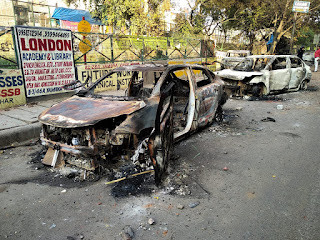 |
(Pic courtesy: Gopal Dutt Sharma) |
In India, it may. But many a times it cannot. This despite the fact that media -- especially TV news -- is said to be self-regulatory.
Take the example of a government ban on two Malayalam (Kerala) news channels over their coverage of violence in Delhi. The 48-hour embargo, imposed on February 6 was however revoked the next day following “representation” from the channels, reported news outlets.
Take the example of a government ban on two Malayalam (Kerala) news channels over their coverage of violence in Delhi. The 48-hour embargo, imposed on February 6 was however revoked the next day following “representation” from the channels, reported news outlets.
The order reportedly included… "Channel's reporting on Delhi violence seems to be biased as it is deliberately focusing on the vandalism of CAA supporters...
It also questions RSS and alleges Delhi Police inaction. Channel seems to be critical towards Delhi Police and RSS…".
 |
(Pic courtesy: Gopal Dutt Sharma) |
If so, is this an official statement on who, or what the media cannot or should not "criticize"?
Not the first time Indian media critical of the
government of the day was “banned”. It was perhaps worse between 1973 and 1975
– when there were not as many media platforms. Media houses face similar
censure in various states and in many cities too.
 |
Gokulpuri, the day after (Pic courtesy: Gopal Dutt Sharma) |
In 1988, the Rajiv Gandhi-led government was forced to
withdraw a “Defamation Bill”. In 2018, a guideline issued by the Information
and Broadcasting Ministry – stating that if a journalist created or propagated
fake news, his/her accreditation may be canceled – had to be withdrawn. Both
times, Prime Minister had to intervene for revoking…
And on so-called social media, we find complaints on what
“media does not report”! That comes from both sides of the divide. That
manifests into hatred, then anger, then physical intimidation.
Recently, many colleagues and friends were up against
bullying and terror in the Delhi flare-up. They were abused, harassed and even
thrashed. Their rendition of the horror underlines the difficult path they
tread.
 |
Loss of property: Burnt cars (Pic courtesy: TV grab from News Time) |
While a particular breed of media is welcomed by a
particular mob, the “others” are intimidated.
My first brush with such hatred and anger was in 1992 in
Ayodhya . Even as I set foot there, the tension was palpable. The mob was
incited following a particular story by a foreign news organization.
What happened that day and thereafter is known to all. The
experience still haunts me!
Not too long back, reporters from Right-leaning TV news
channel had to hide their identity when covering the row at Jawaharlal Nehru
University. Similarly, those sympathizing with the JNU Students’ Union were
harassed by the “other side”.
In early 20s, the Left Front government in West Bengal
did not spare critics. Reporters from a popular Bengali news production house
had then earned the wrath of comrades to the extent that even their newsroom
was raided. Even the present state government treats criticism mostly with an
iron hand.
The story repeats elsewhere too. And add to it the
uncertainties in covering insurgency and natural calamities…
According to Reporters Without Borders (RSF) “Violence
against journalists – including police violence, attacks by Maoist fighters,
and reprisals by criminal groups or corrupt politicians – is one of the most
striking characteristics of the current state of press freedom in India…” This
report early last year highlighted the many dangers Indian journalists face, “especially
those working for non-English-language media outlets in rural areas”.
According to news agency PTI in 2019, India dropped down two
notches in World Press Freedom Index ranking 140th out of 180 countries. The
Press Freedom Index is an annual ranking of countries compiled and published by
RSF. The index only deals with press freedom and does not measure the quality
of journalism nor does it look at human rights violations.
Journalism can indeed be dangerous, rendered more hazardous
by some with vested interest from outside – perhaps more so from inside – the profession.
(In case of any criticism or suggestion, write to @jayantab15 on Twitter / Facebook or jayantab15@gmail.com)

Comments
Post a Comment